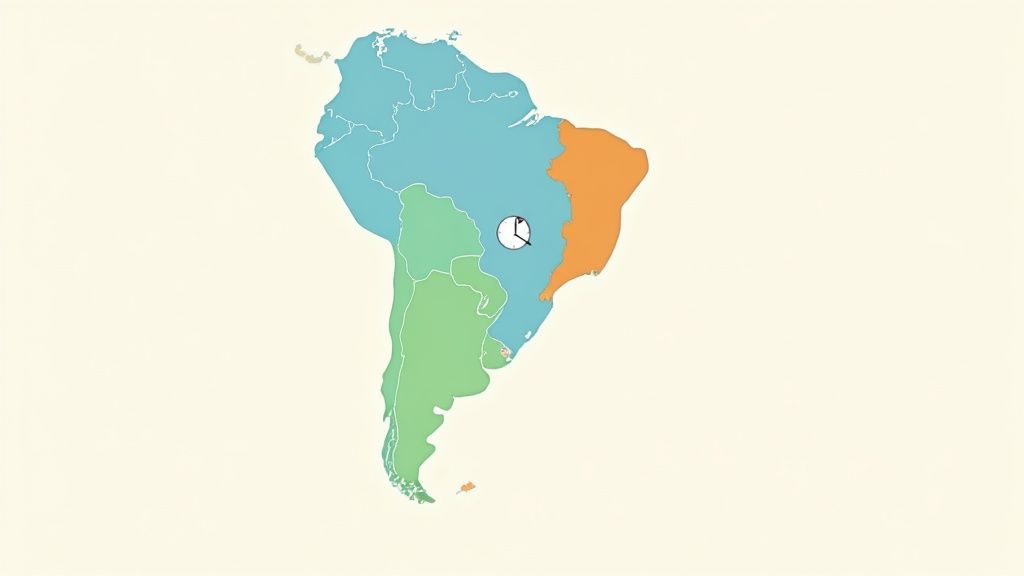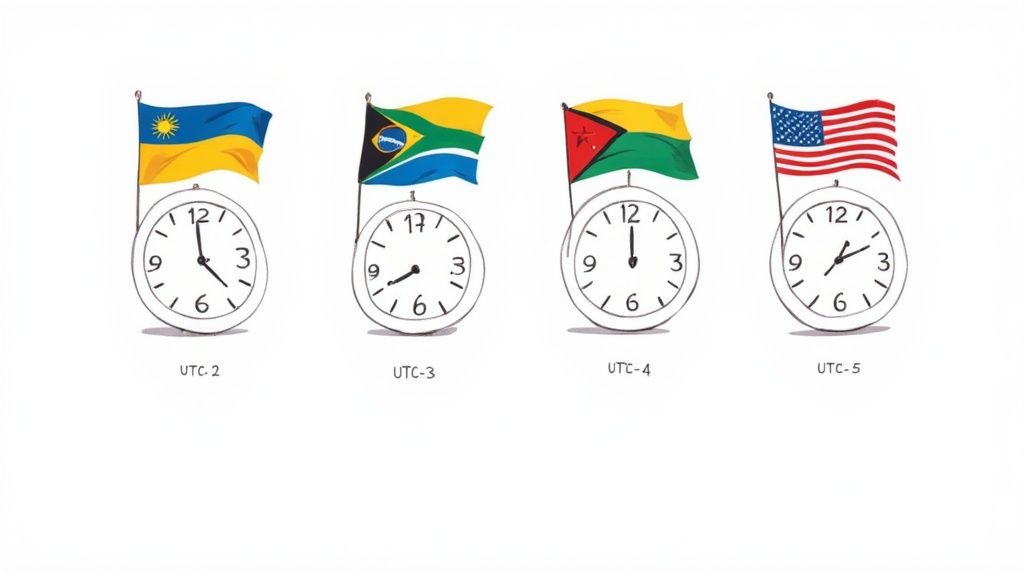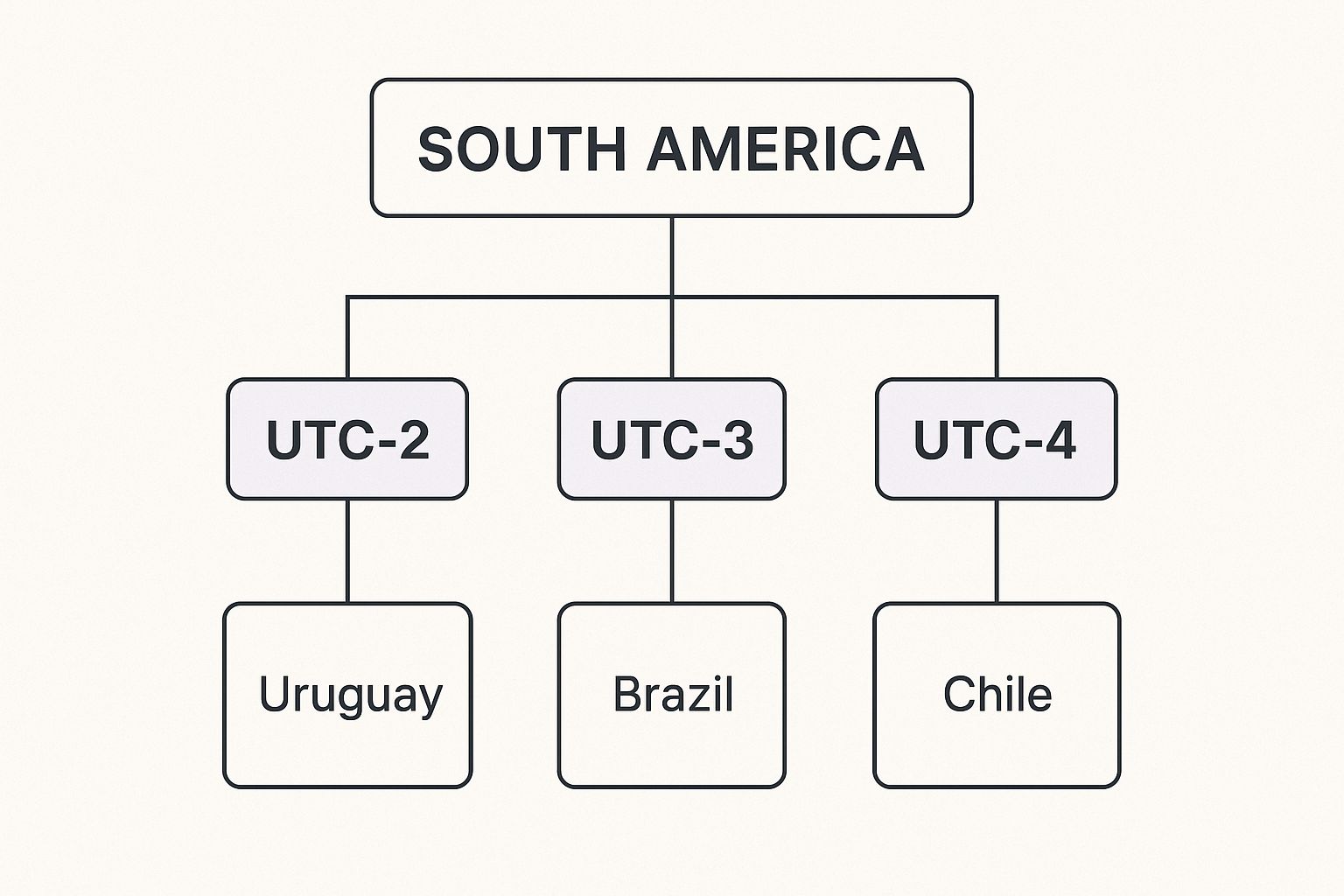
If you're coordinating with a team in South America, the first thing to know is there's no single "South America Time Zone." The continent is massive, so time is determined country by country, with most falling between UTC-5 and UTC-3.
Figuring out the local time across this vast continent can feel like a puzzle, but it’s more straightforward than it looks. The key is remembering that most countries operate within a three-hour band. For instance, if your colleagues are in Colombia or Peru, they're on UTC-5, while the team in Brazil's major cities is on UTC-3.
This spread is a direct result of the continent's sheer longitudinal width. Brazil is the perfect example. As the largest country, it officially uses four different time zones to keep things running smoothly, ranging from UTC-5 in its far-western states all the way to its primary Brasília Time at UTC-3. You can dig deeper into South America's geography to see how it shapes everything, including timekeeping.
To make things a little easier, here’s a quick reference table covering the standard, non-Daylight Saving Time offsets for the major players on the continent.
This table gives you a at-a-glance look at the primary standard time zones used across South America. Keep in mind, this doesn't account for Daylight Saving Time (DST), which can add another layer of complexity in some countries.
| Country | Primary Standard Time Zone (UTC Offset) |
|---|---|
| Argentina | UTC-3 |
| Bolivia | UTC-4 |
| Brazil | UTC-3 (Brasília Time) |
| Chile | UTC-4 (Mainland) |
| Colombia | UTC-5 |
| Ecuador | UTC-5 |
| Paraguay | UTC-4 |
| Peru | UTC-5 |
| Uruguay | UTC-3 |
| Venezuela | UTC-4 |
Again, this is just a starting point. Larger countries like Brazil and Chile have exceptions and multiple zones, so always double-check the specific city you're dealing with.
Key Takeaway: When scheduling anything in South America, get specific. Never assume a single continental time exists—always mention the country or, even better, the city. A quick check of the UTC offset is the only surefire way to avoid confusion and missed meetings.

When you're trying to figure out the time zone for South America, a country-by-country breakdown is your best bet. Because the continent is so vast, there’s no single answer. This directory breaks down the standard times, Daylight Saving Time (DST) rules, and any weird exceptions for all 12 sovereign nations.
Think of this as your quick-reference guide for scheduling meetings or coordinating projects without any confusion.
Argentina
Argentina sticks to a single time zone, Argentina Time (ART), which is UTC-3. While the country has experimented with DST in the past, it officially dropped the practice back in 2009. That makes things simple: their time is consistent all year long.
Bolivia
Bolivia is straightforward. The entire country observes Bolivia Time (BOT), set at UTC-4. They don't do Daylight Saving Time, so their UTC offset never changes.
Brazil
As the largest country on the continent, Brazil is a special case with four official time zones. Most of the population, including major hubs like São Paulo and Rio de Janeiro, uses Brasília Time (BRT) at UTC-3. Other regions fall into UTC-4 (like Amazonas and Rondônia) or UTC-5 (Acre). Brazil permanently ended DST in 2019, which helps simplify things a bit.
Chile
Chile’s timekeeping can get a little tricky, so pay close attention here. Mainland Chile uses UTC-4 as its standard time. However, the country observes DST, jumping forward to UTC-3 from the first Saturday in September to the first Saturday in April.
Chile also has a couple of important exceptions you need to know about:
Colombia
Colombia keeps it simple with one time zone for the whole country: Colombia Time (COT), which is UTC-5. They do not observe DST, so the time is always the same. This conveniently aligns it with U.S. Eastern Standard Time during the North American winter.
Ecuador
Mainland Ecuador uses Ecuador Time (ECT), set at UTC-5, and does not follow DST. But the big exception here is the world-renowned Galápagos Islands. They operate on their own time zone, Galápagos Time (GALT), which is UTC-6.
Pro Tip: When scheduling with someone in Ecuador, always ask if they're on the mainland or the Galápagos. That one-hour difference is a classic mix-up for travelers and remote teams alike.
Guyana
Guyana observes Guyana Time (GYT), which is set at UTC-4. The country does not use Daylight Saving Time, so its clock is consistent year-round.
Paraguay
Paraguay is one of the few South American countries that still consistently observes DST. Its standard time is Paraguay Time (PYT) at UTC-4. During its summer months, it switches to Paraguay Summer Time (PYST) at UTC-3.
Finally, let's round out the list to make sure we’ve covered every nation. These last four keep things pretty straightforward.
Brazil's sheer size makes it one of the few South American countries with multiple time zones, a fact that can easily trip up even seasoned travelers and schedulers. The nation officially runs on four different clocks, which has a direct impact on everything from domestic flights to national TV broadcasts.
For instance, flying from Rio Branco in the state of Acre (UTC-5) to the capital, Brasília (UTC-3), means jumping forward two full hours. It's a small detail that can have big consequences if you're not prepared.
This complexity is a direct result of the country's massive geography. Brazil spans from UTC-5 on its western edge to UTC-2 on its remote Atlantic islands. The political and economic heart of the nation, however, beats on Brasília Time (UTC-3). This single zone is home to about 65% of Brazil's 213 million people and includes major cities like São Paulo and Rio de Janeiro. For a wider perspective on how this compares to other large countries, you can explore more about global time zone classifications.
The infographic below gives you a bird's-eye view of how some of the continent's major time zones are distributed.

As you can see, neighboring countries like Argentina and Bolivia fall into different, though adjacent, time bands, underscoring the importance of checking local times before scheduling any cross-border communication.
To make scheduling easier, it helps to know which regions use which offset. Here’s a quick breakdown:
One of the most significant changes for international scheduling came in 2019, when Brazil officially did away with Daylight Saving Time (DST). This decision means Brazil’s time zones are now stable year-round. While this simplifies planning in some ways, it also means the time difference with countries that do observe DST will change twice a year, so always double-check.
If there's one thing that trips up even seasoned managers scheduling across continents, it's Daylight Saving Time (DST). When it comes to the time zone for South America, DST adds a layer of complexity that can feel like a moving target. The continent is a real patchwork—some countries observe it, others have ditched it entirely, and a few never bothered with it in the first place. This inconsistency is a classic source of missed meetings and scheduling headaches.
For instance, countries like Chile and Paraguay are still on the DST train, springing forward one hour in their spring and falling back in their autumn. But don't get too comfortable; their start and end dates rarely line up with schedules in North America or Europe.
The rules can and do change, so it's always a good practice to double-check the current local time. But here's a general breakdown of the current situation:
The takeaway here is simple: what was true last year might not be true this year. Before you lock in any plans, a quick search for the current local time is non-negotiable.
This constant state of flux is particularly critical for remote teams. Getting a handle on these regional quirks is a core part of making cross-continental collaboration work smoothly. You can dig deeper into the role of time zones in remote work to make sure your team stays perfectly in sync, no matter where they are.

So, you're ready to coordinate with partners or new hires in South America. The good news is that the time zone for South America often lines up beautifully with the US, making real-time collaboration a breeze. It’s one of the biggest practical advantages of nearshoring to the region.
Take countries like Colombia and Peru, for example. They operate on UTC-5 all year. During the winter, that’s exactly the same as US Eastern Standard Time (EST), which means zero time difference to worry about. Even major business hubs like São Paulo, Brazil (UTC-3), are only two hours ahead of the US East Coast, leaving plenty of overlapping work hours for calls, demos, and stand-ups.
To get a clear picture of how your workdays align, we put together this quick reference table. It’s designed to help you find the sweet spot for scheduling calls between major business centers.
| US East Coast (EST/EDT) | US West Coast (PST/PDT) | Bogotá, Colombia (UTC-5) | São Paulo, Brazil (UTC-3) |
|---|---|---|---|
| 10:00 AM | 7:00 AM | 10:00 AM | 12:00 PM |
| 1:00 PM | 10:00 AM | 1:00 PM | 3:00 PM |
| 4:00 PM | 1:00 PM | 4:00 PM | 6:00 PM |
As you can see, there’s a solid window in the late morning and early afternoon (US East Coast time) where everyone is online and available.
Of course, knowing the time zones is only half the battle. To make those meetings count, you need solid practices. For great insights, check out these effective meeting management tips. And to get even deeper into building your cross-border team, have a look at our guide on https://lathire.com/time-zone-differences-when-hiring-from-latam/.
Knowing the time zones is one thing; putting that knowledge into practice without causing a scheduling nightmare is another. To turn your understanding of the time zone for South America into error-free planning, you just need the right tools and a few smart habits.
A reliable online time zone converter or world clock app should be your first stop for any quick check. These tools take the guesswork out of the equation, giving you real-time accuracy, which is especially critical when you're dealing with countries that may or may not be observing Daylight Saving Time.
Beyond apps, a few simple communication tweaks can prevent the vast majority of scheduling mishaps. Getting these habits down ensures everyone is on the same page, no matter where they are.
For keeping your own day straight, platforms like Google Calendar for scheduling tasks are built with time zone awareness in mind, making them indispensable for managing a cross-continental schedule.

As you start working with teams across this massive continent, a few key questions almost always come up. Here are some straightforward, practical answers to help you sidestep common scheduling headaches, whether you're a traveler, remote manager, or global professional.
That would be Brazil, hands down. Because of its sheer size, it officially covers four time zones, stretching from UTC-5 on its western edge with Peru all the way to UTC-2 for its remote Atlantic islands.
But here’s the key takeaway: the overwhelming majority of Brazil’s population and its economic powerhouses like São Paulo and Rio de Janeiro run on Brasília Time (BRT), which is UTC-3.
Not anymore. Daylight Saving Time (DST) has become increasingly rare across South America. While a couple of countries like Chile and Paraguay still spring forward and fall back, most nations have ditched the practice for the sake of consistency.
Major players like Brazil, Argentina, Peru, Colombia, and Uruguay no longer change their clocks. This actually makes year-round scheduling a lot simpler.
Important Note: You absolutely must verify the current DST rules for Chile and Paraguay before scheduling anything important. Their start and end dates can shift and rarely align with North American or European schedules. A quick check upfront can prevent a world of miscommunication.
The best strategy is to be crystal clear and lean on reliable tools. When you send a calendar invite, always specify the time using a UTC offset (for example, "10:00 AM UTC-5") instead of relying on a city name alone. This simple step eliminates any and all guesswork.
For teams, mastering these differences isn't just a convenience—it's a fundamental part of running a smooth operation. To get a better handle on this, it's worth exploring the challenges of time zone differences when hiring from LatAm and learning how to build a truly integrated team.
